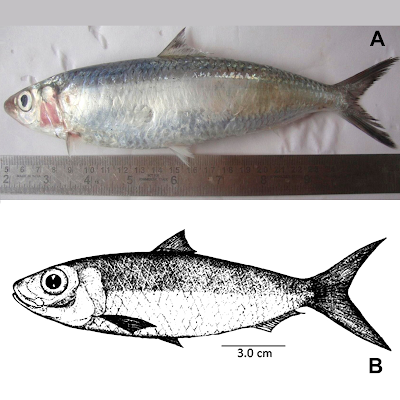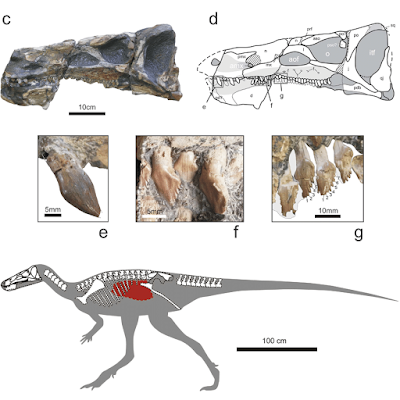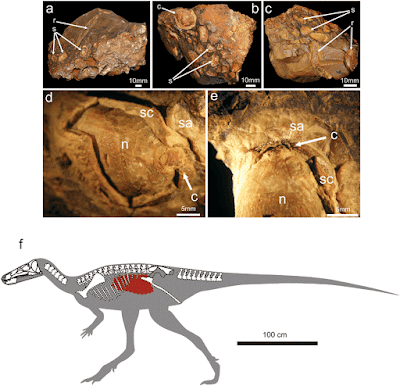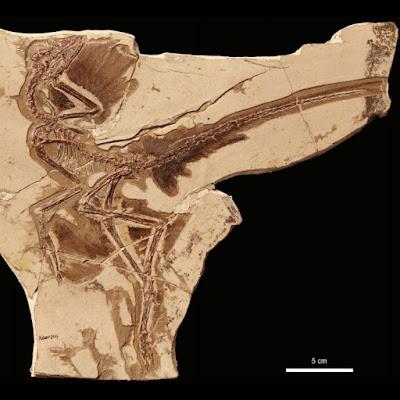[Most Recent Entries] [Calendar View]
Thursday, April 27th, 2017
| Time | Event | ||||
| 12:07a | [Ichthyology • 2017] Amblygaster indiana • A New Species of Clupeid Fish (Clupeiformes: Clupeidae), off Eraviputhenthurai, West Coast of India
Abstract A new species, Amblygaster indiana sp. nov., is described from 12 specimens collected from fish landing centers and fish markets at Eraviputhenthurai, west coast of India. The new species can be differentiated from all other species of Amblygaster by its larger size and very deep body, 8 circular-shaped pre-pelvic scutes, different gill rakers counts, large eyes, 40 lateral scales, and peculiar gap between the left and right frontoparietal striae on the top of the head. The new species has been seasonally captured with A. sirm in Eraviputhenthurai and also other coastal waters of the south west coast of India. The proportions of A. indiana sp. nov. and A. sirm in fish catches are approximately 1 to 20. Gillnets and shore seines are used to catch Amblygaster spp. along the Eraviputhenthurai coast and along the coastal zones of south west coasts of India. Keywords: Pisces, Clupeiformes, Amblygaster, new species, west coast of India
A.A. Mary, T. Balasubramanian, S. Selvaraju and A. Shiny. 2017. Description of A New Species of Clupeid Fish, Amblygaster indiana (Clupeiformes: Clupeidae), off Eraviputhenthurai, West Coast of India. Zootaxa. 4247(4); 461-468. DOI: 10.11646/zootaxa.4247.4.7 | ||||
| 10:03a | [Paleontology • 2017] Isaberrysaura mollensis • A New Primitive Neornithischian Dinosaur from the Jurassic of Patagonia with Gut Contents
Abstract We describe a new species of an ornithischian dinosaur, Isaberrysaura mollensis gen. et sp. nov. The specimen, consisting in an almost complete skull and incomplete postcranium was collected from the marine-deltaic deposits of the Los Molles Formation (Toarcian-Bajocian), being the first reported dinosaur for this unit, one of the oldest from Neuquén Basin, and the first neornithischian dinosaur known from the Jurassic of South America. Despite showing a general stegosaurian appearance, the extensive phylogenetic analysis carried out depicts Isaberrysaura mollensis gen. et sp. nov. as a basal ornithopod, suggesting that both Thyreophora and neornithischians could have achieved significant convergent features. The specimen was preserved articulated and with some of its gut content place in the middle-posterior part of the thoracic cavity. Such stomach content was identified as seeds, most of them belonging to the Cycadales group. This finding reveals a possible and unexpected role of this ornithischian species as seed-dispersal agent. Systematic palaeontology Ornithischia Seeley, 1887 Genasauria Sereno, 1986 Neornithischia Sereno, 1986 Isaberrysaura mollensis gen. et sp. nov. Etymology: In honour of Isabel Valdivia Berry, who reported the finding of the holotype material. Holotype: MOZ-Pv 6459. A skeleton comprising a nearly complete skull, and a partial postcranium (still unprepared) consisting of 6 cervical vertebrae, 15 dorsal vertebrae, a sacrum with a partial ilium and an apparently complete pubis, 9 caudal vertebrae, part of a scapula, ribs, and unidentifiable fragments. Type locality and horizon: The holotype comes from the locality of Los Molles (Neuquén Province, Argentina) (Fig. 1). The specimen was found in the marine-deltaic deposits of the Los Molles Formation (Toarcian-Bajocian), which in this sector reaches a thickness of approximately 1,042 m. The fossil-bearing level is composed of laminated pelites rich in ammonitiferous concretions and vertebrate remains, located some 40 m below the contact with the overlying unit (Lajas Formation, Bajocian-Bathonian). The presence of the ammonite Sonninia altecostata allows the fossil-bearing level to be situated biochronologically in the early Bajocian. In palaeoenvironmental terms, the sedimentary succession comprises a large-scale progradational deltaic system, dominated by wave action and the influence of storms. The dinosaur remains described here, the first reported from this unit, are among the oldest from Neuquén Basin. Leonardo Salgado, José I. Canudo, Alberto C. Garrido, Miguel Moreno-Azanza, Leandro C. A. Martínez, Rodolfo A. Coria and José M. Gasca. 2017. A New Primitive Neornithischian Dinosaur from the Jurassic of Patagonia with Gut Contents. Scientific Reports. 7: 42778. DOI: 10.1038/srep42778 | ||||
| 10:09a | [Paleontology • 2017] New Specimens of Anchiornis huxleyi (Theropoda, Paraves) from the late Jurassic of northeastern China Abstract Four new specimens of Anchiornis huxleyi (PKUP V1068, BMNHC PH804, BMNHC PH822, and BMNHC PH823) were recently recovered from the late Jurassic fossil beds of the Tiaojishan Formation in northeastern China. These new specimens are almost completely preserved with cranial and postcranial skeletons. Morphological features of Anchiornis huxleyi have implications for paravian character evolution and provide insights into the relationships of major paravian lineages. Anchiornis huxleyi shares derived features with avialans, such as a straight nasal process of the premaxilla and the absence of an external mandibular fenestra in lateral view. However, Anchiornis huxleyi lacks several derived deinonychosaurian features, including a laterally exposed splenial and a specialized raptorial pedal digit II. Morphological comparisons strongly suggest Anchiornis is more closely related to avialans than to deinonychosaurians or troodontids. Anchiornis huxleyi exhibits many conservative paravian features, and closely resembles Archaeopteryx and other Jurassic paravians from Jianchang County, such as Xiaotingia and Eosinopteryx. The other Jianchang paravian, Aurornis xui, is likely a junior synonym of Anchiornis huxleyi. Rui Pei, Quanguo Li, Qingjin Meng, Mark Norell and Keqin Gao. 2017. New Specimens of Anchiornis huxleyi (Theropoda, Paraves) from the late Jurassic of northeastern China. Bulletin of the American Museum of Natural History. 411. URI: hdl.handle.net/2246/6707 |
| << Previous Day |
2017/04/27 [Calendar] |
Next Day >> |









